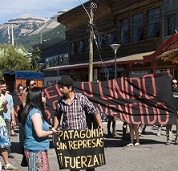
After eight years of demonstrations and sometimes violent protests, officials rejected the controversial Patagonian dam project last week. The decision halts development of what would have become Chile’s largest energy endeavor in history, the building of five dams in two of South America’s widest rivers along with 1,600 km of power lines through pristine Andean valleys and fjords to carry energy to the nation’s central regions. Patricio Rodrigo, executive secretary of the Patagonia Defense Council, called the moment “the greatest triumph of the environmental movement in Chile.”
![]() Photo Caption: Rio Baker, the sight of one of five proposed HidroAysén dams in Southern Chile – Photo by Diego Cupolo
Photo Caption: Rio Baker, the sight of one of five proposed HidroAysén dams in Southern Chile – Photo by Diego Cupolo
After eight years of demonstrations and sometimes violent protests, Chilean environmentalists popped champagne bottles and celebrated outside the ministry building after officials rejected the controversial Patagonian dam project last week.
The decision halts development of what would have become Chile’s largest energy endeavor in history, the $8B HidroAysén hydroelectric project, which involved building five dams in two of South America’s widest rivers along with 1,600 km of power lines through pristine Andean valleys and fjords to carry energy to the nation’s central regions.
In a report by the Associated Press, Patricio Rodrigo, executive secretary of the Patagonia Defense Council, called the moment “the greatest triumph of the environmental movement in Chile.”
It “marks a turning point, where an empowered public demands to be heard and to participate in the decisions that affect their environment and their lives,” Rodrigo continued.
Chile’s former President Sebastián Piñera gave HidroAysén a partial green light to begin construction in May 2011, but the project was repeatedly delayed as various citizen groups organized campaigns and held protests throughout the country.
A widely debated issue that divided much of the country, Chile’s president incumbent Michelle Bachelet was critical of the project during her campaign and expedited the decision process when she took office in March 2014. As a result, Chile’s Committee of Ministers voted unanimously to reject the HidroAysén dam project after reviewing 35 pending appeals.
“A decision was taken to accept the community appeals and void the Environmental Qualification Resolution that approved HidroAysén; so the project is declared rejected by this administrative act,” Environment Minister Paul Badenier told the Wall Street Journal.
Badenier also said the new administration had welcomed a number of alternative energy projects to supply Chile’s rising energy needs, adding: “There are alternatives in projects that have been submitted but not yet carried out.”
According to the Natural Resources Defense Council, the committee’s decision was based on three critical faults: “the lack of a relocation plan for people affected by the dams, inadequate evaluation of the impacts of changes to the ecosystem’s hydrology; and inconsistences with regard to the baseline for terrestrial wildlife that made it impossible to quantify impacts and determine mitigation and compensation measures.”
“This project has many aspects that were poorly thought out,” Energy Minister Maximo Pacheco told Reuters at the end of a three-hour meeting to discuss the project.
The number one copper producing country in the world, much of Chile’s economy relies on the energy-intensive mining industry, which in one form or another, will require new energy projects to keep expanding in the neat future. HidroAysén was planned to generate 2,750 megawatts, almost a third of central Chile’s current needs, which is a significant figure for a country lacking domestic oil and natural gas resources.
Environmentalists have long pointed to Chile’s Atacama Desert, the driest place on earth, as an optimal sight for massive solar energy developments, but alternative projects have yet to receive approval.
HidroAysén is 51 percent owned by European energy generator Endesa and 49 percent owned by the Chilean company Colbun SA. In response to the ruling, Endesa released a statement saying it would wait before taking further action.
“It’s clear that there has been a change in the Chilean government’s attitude toward HidroAysén, and that the project in its current format has not garnered sufficient support from the authorities,” Endesa representatives wrote in the statement.
According to the Associated Press, Endesa can appeal the decision before an environmental court and analysts expect a long legal battle.
Diego Cupolo is an independent journalist, photographer and author of Seven Syrians: War Accounts From Syrian Refugees, released January, 2014, by 8th House Publishing. He serves as Latin America regional editor for Global South Development Magazine. See more of his work at www.diegocupolo.com
Sources / Further Reading:
1. Tough Questions for Chile as Ongoing Protests Stall Patagonian Dam Project – Upside Down World
2. Chile rejects $8B US HidroAysen dam in Patagonia – Associated Press
3. Patagonia Sin Represas Website (Patagonia Without Dams)
4. Chile Rejects HidroAysen Hydroelectric Project – Wall Street Journal
5. Latin America Green News: Chile Rejects HidroAysen – Natural Resources Defense Council
6. Chile Rejects HidroAysen, hydro power project can appeal – Reuters
7. Endesa takes wait-and-see approach to HidroAysen – BNamericas
